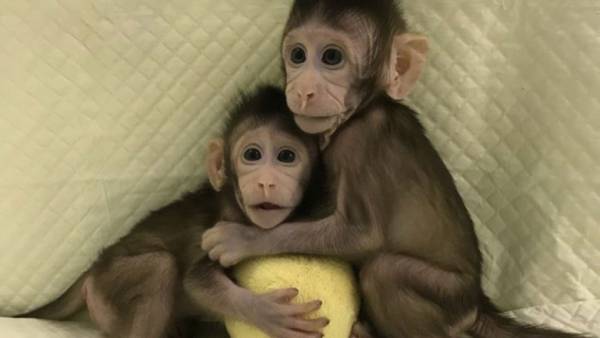From the sheep to the monkey: Chinese monkeys cloned
Chinese scientists have cloned a monkey by the same method as Dolly the sheep. Perspectives for research and concerns the Vatican says “Газета.Ru”.

Chinese scientists have cloned a monkey in the same way as the famous Dolly the sheep. Your achievement they reported in the journal Cell.
Macaque crabeater Junjun and hoihoi got their names from the Chinese word Zhonghua, meaning the Chinese people, as a sign of the national importance of this event. Age of kids to date is six to eight weeks, they are on artificial feeding.
This is not the first case of cloning monkeys, however, the previously used method, in which the already fertilized embryo into several parts, which led to the birth of several genetically identical single-mode Gemini, monkeys.
News Genetically modified pig organ donors for humans?
Genetically modified pig organ donors for humans?
In 1996, with transfer of genetic information taken from a somatic (asexual) cells, the egg was cloned sheep Dolly. Nuclear transfer of somatic cells (somatic cell nuclear transfer — SCNT) involves the creation of an embryo from the egg and differentiated (adult) somatic (i.e., asexual) cells. Is removed from the egg’s own genetic material, and in its cytoplasm is placed into the nucleus of somatic cells.
After that, scientists in the same way cloned mice, pigs, cows, dogs and other animals, but to set up an experiment with primates did not succeed.
When in 2003 at the University of Pittsburgh scientists are unable to create a single clone of the 716 eggs, it has been suggested that primates this method is not suitable.
Nuclei of somatic cells of monkeys, in contrast to the cells of mice and cows, were resistant to SCNT. The researchers were able to achieve success by using epigenetic modulators that are applied after migration of a nucleus — they are included or switched off certain genes, on which depended the development of the embryo. As it turned out, it is best suited for the experiment, fibroblasts — connective tissue cells — taken from the embryo of a monkey. Scientists have tried to use cells of adult individuals, but clones only survived for a few hours.
We tried some different methods but only one worked. We are faced with many failures, before being able to clone a monkey.Qiang Serveuse author of the study
Of the 127 109 oocytes developed into embryos, 79 of them were hooked 21 surrogate mother. Became pregnant six of them. Only two calves were born alive.
“SCNT is a very delicate procedure, so the sooner it is held, the less damage will be caused to the egg, the researchers said. — Not everyone can quickly and accurately implement it, so that the optimization of the transfer of the nucleus into the oocyte is likely to greatly helped us to succeed.”
The news Cloning will help in the treatment of diabetes
Cloning will help in the treatment of diabetes
Scientists hope that the lines are genetically identical monkeys can be used for laboratory purposes.
“There are many questions about the biology of primates, which can be studied using this model, says Qiang sun, lead author of the study. — We can create monkey clones with the same genome, except for a few genes. So we will be able to study not only, for example, genetically caused brain diseases, but cancer, immune diseases and metabolic disorders. This will allow us to test the effectiveness of drugs to treat these diseases before their clinical application”.